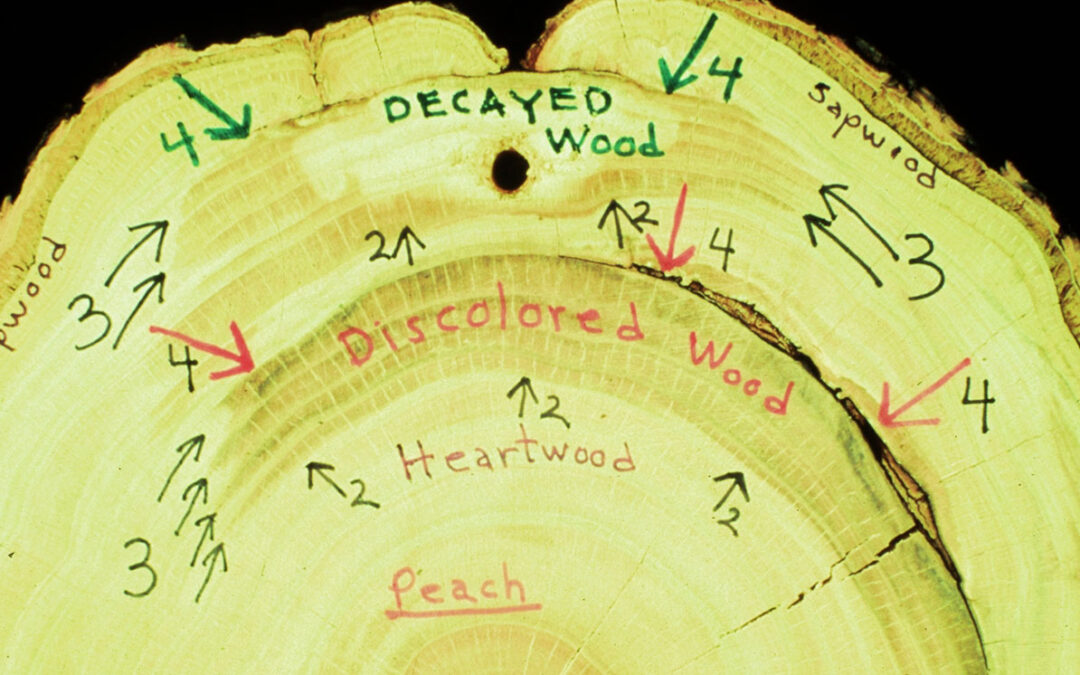Trees are among Earth’s most successful life forms in terms of longevity, size, and ecological dominance. They are around 370 million years old and found on all continents besides Antarctica. Lifeforms that successfully have ways to content with harm, rot, and disease. Trees form specialized tissues that respond to injury or infections by compartmentalization (CODIT), which walls off the contagion from healthy tissue over long periods.
The German forester Robert Hartig studied how trees reacted to decay in the late 19th century and pioneered tree pathology. He created a concept called Compartmentalization of Decay in Trees or CODIT. A concept cannot be proven or disproven, but more research develops it further, making it a better model to explain how trees react to harm. In 1970, United States Forest Service Plant Pathologist A. L. Sigo agreed that wounds allow wood decay organisms to enter. However, he stated that other microorganisms, including bacteria and fungi, cause trees to wall off affected tissues from healthy tissue. He changed CODIT to mean Compartmentalization of Damage/Dysfunction in Trees. His goal was to make the science of tree compartmentalization accessible to forestry and arboriculture practitioners.
Tree Anatomy
Bark – Trees have bark that protects them from the elements, diseases, and insects. The bark keeps out moisture and prevents desiccation. It insulates against cold and heat and wards off insect pests.
Phloem – Next is the phloem, which acts like a pipeline, moving water and nutrients from the leaves to the roots. The short-lived vascular tissue dies and turns into the inner bark.
Cambium – Next to the phloem is a thin layer called the cambium, which is several cells thick. The growth layer makes new cells during the growing season, becoming part of the phloem or xylem or making the cambium thicker. The cambium adds girth to the trunk, branches, and roots.
Sapwood – Sapwood, or xylem, is a new living tissue that moves water from the roots to the leaf buds. As the new tissue forms rings, the older sapwood dies and turns into the heartwood.
Heartwood – Heartwood is composed of cellulose fiber joined by lignin and provides the strength for support.
Pathogen or Physical Damage
The CODIT process starts when trees sense they are being attacked or injured. Trees have sensors called pattern recognition receptors that allow plants to sense molecules associated with damage or pathogens. Pattern-triggered immunity identifies threats by type and can even detect different classes of fungi. Another trigger is air in internal tissues when there is a break in the bark from mechanical damage, pathogens, or insects. Trees convert some carbohydrate reserves into secondary metabolites and transport these compounds through the xylem, starting the CODIT process to protect the tree.
Compartmentalization of Damage/Dysfunction (CODIT)
The CODIT process produces Walls I, II, III, and Wall IV barrier zones. The tree uses the four walls to resist the spread of decay or pathogens. The relative strength of each wall increases from I through to IV.
Wall I resists the vertical spread of dysfunction from the wound site. It is naturally weak because the tree needs vascular connectivity for the axial transport of water and nutrients. Surrounding parenchyma cells produce balloon-like Tyloses to fill the vessels and form Wall I to slow the progress of rot and pathogens.
Wall II is the tangential wall inhibiting the movement of decay organisms inward and forming along growth ring cells. Wall II is continuous except where rays pass through.
Wall III is composed of ray cells, which inhibit the movement of decay in a radial direction.
Wall IV is the strongest protective wall formed by the cambium layer and restricts the movement of decay into tissues formed after wounding. The cells are thick-walled and contain chemicals to ward off decay.
Some tree species compartmentalize better than others. Healthy tree compartmentalization is better than trees in a weakened condition. Vigor gives trees more energy and stored carbohydrates to respond to attacks. Periodic fertilization, pruning out deadwood, watering during dry periods, and controlling insects and diseases improve tree health and are essential in helping trees compartmentalize pathogens and decay.
Proper Pruning
Proper tree pruning saves money because healthy trees need less maintenance and resist disease and insects. The best way to ensure good tree service is to hire a company like Ross Tree with International Society of Arboriculture (ISA) Certified Arborists on staff. Trained arborists know to make pruning cuts just outside the branch collar to avoid damaging the trunk and compromising wound responses. Improper pruning can lead to internal decay and severe harm. Click here to find out more information about standards-based Pruning.
Wound Treatment
Tree surgeons should shape fresh wounds into an ellipse to speed wound closure. They must avoid injuring any callus tissue that may have formed at wound margins. Callus tissue develops around and eventually over the wound surface. Damaging the callus can lead to decay and breaking Wall IV barrier zones.
Injection Wounds
Ross Tree was the first tree company in Denver to offer tree injections, a practicable alternative to spraying trees. Using systemics ensures that only the tree gets the product, not the surrounding environment. We make small-diameter injection holes that are shallow and clean-edged. We avoid repeating injections in the same area. We do not plug injection holes to avoid decay risks and interfering with wound closure.
Cabling And Bracing
Cabling and bracing should be installed into healthy wood because the resulting wounds are compartmentalized. When placing hardware in decayed wood, the rods or eyebolts must pass completely through the trunk or limb and held in place with washers and nuts. Do not use lag-bolts in decayed wood.
Ross Tree is a locally owned and licensed Denver tree company in business since 1978. We offer standards-based tree and plant health care services to residential and commercial property owners. Call us at 303-871-9121 or fill out a requests service form to make an appointment.




